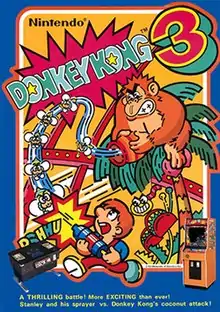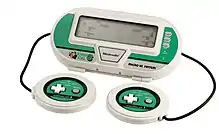Donkey Kong 3
Donkey Kong 3[lower-alpha 1] is the third video game in the original Donkey Kong series by Nintendo. It was released in arcades in 1983 and the Family Computer in 1984, then later released in America for the Nintendo Entertainment System in 1986. The gameplay departs from previous Donkey Kong games, being primarily a shooter, and starring an exterminator named Stanley instead of Mario.[1]
| Donkey Kong 3 | |
|---|---|
 European arcade flyer | |
| Developer(s) | Nintendo R&D1 |
| Publisher(s) | Nintendo |
| Director(s) | Shigeru Miyamoto |
| Producer(s) | Gunpei Yokoi |
| Composer(s) | Hirokazu Tanaka |
| Series | Donkey Kong |
| Platform(s) | Arcade Famicom/NES |
| Release | |
| Genre(s) | Shooter |
| Mode(s) | Single-player, multiplayer |
The game was re-released on the Wii Virtual Console in North America on July 14, 2008 and in Europe on January 9, 2009.
Gameplay

Donkey Kong hangs from vines at the center of the screen, and the player-controlled Stanley the exterminator runs and jumps on platforms beneath him. Stanley can fire bug spray at both Donkey Kong and insects flying around the levels. A level is completed by continually using bug spray on Donkey Kong, forcing him to the top of the screen, or by killing all of the bugs. A super spray can on the vines falls down when Donkey Kong is sprayed past it. The super spray only lasts for a limited amount of time, but it pushes Donkey Kong upward at a much faster rate, making it easier to complete the level. It only spawns at the start of each life.
The insects are Buzzbees, Beespies, queen bees (which shatter into deadly pieces when destroyed), Creepy Caterpillars, butterflies, beetles, moths, Beebombs and vine eaters. Some of the flying insects attempt to pick up the flowers at the bottom of the screen and carry them away. Lost flowers decrease the bonus at the end of the round.
There are three levels which repeat in a fixed sequence.
An extra life is given at 50,000 points, and then the game goes to "survival of the fittest" mode thereafter.
Plot
Stanley is a bugman. Donkey Kong has taken refuge in his greenhouse and it is now up to Stanley to stop the ape from stirring up any more insects that will soon destroy his flowers. Stanley saves the flowers by spraying bug spray on Donkey Kong.[2]
Reception
Reviews for the game were generally positive and was moderately successful in Japan. Despite this, it was a commercial failure in North America, particularly due to the wake of the video game crash of 1983. In Japan, Game Machine listed Donkey Kong 3 on their December 1, 1983 issue as being the fourth most-successful new table arcade unit of the year.[3] Computer and Video Games said that the game's "fast action and superior sound effects" made Donkey Kong 3 a "sure hit" in arcades.[2]
Reception, retrospectively, has been divisive, with criticism aimed at its departure of its predecessors and the lack of Mario. IGN gave the Virtual Console version a 6.0 out of 10, describing it as a "radical departure" from the previous Donkey Kong games, calling it "repetitive."[4]
Legacy

A VS. series Game & Watch version of the arcade game has different gameplay. In this version, player one controls Stanley the Bugman and computer player (or player two) controls Donkey Kong in a duel against each other using exterminating spray cans to move the bees to the other side of them to make the bees sting their opponents. Players can only hold up to three amounts of spraying liquid in their spray cans. On one player mode, the higher player one as Stanley scores, the faster the spraying liquid on the side of computer player as Donkey Kong drops. A version of this game was included in Game & Watch Gallery 4 for the Game Boy Advance, but featuring Mario in place of Stanley and a Boo and a Fireball in place of the bees.
The NES version of Donkey Kong 3 was released on the Wii Virtual Console, 3DS Virtual Console and Wii U Virtual Console,[5] whilst the arcade version was released on the Nintendo Switch eShop as part of Hamster's Arcade Archives series.
Semi-sequel
In 1984, Hudson Soft developed a semi-sequel for the Japanese-only NEC PC-8801, NEC PC-6601, and Sharp X1 personal computers titled Donkey Kong 3: The Great Counterattack.[lower-alpha 2][6] A version for the FM-7 was also planned, but was never released.[7] This game is significantly different from the original. While the object to shoot Donkey Kong up in the air remains, it has 20 outdoor backgrounds such as a bridge, Planet Saturn, a desert, a pyramid, and a highway. Stanley can only move from left to right and is no longer able to jump.
For decades, Donkey Kong 3: The Great Counterattack was inaccessible outside of Japan. In December 2017, a copy of the Sharp X1 version was bought at a Yahoo! Auctions online auction. In February 2018, it was made available via emulation. The PC-8801 version was subsequently uncovered in January 2019.[6]
Notes
References
- "Donkey Kong 3". Arcade History.
- "Donkey Kong Swings Back." Computer and Video Games. February 1984. p. 50.
- "Game Machine's Best Hit Games 25 - テーブル型新製品 (New Videos-Table Type)". Game Machine (in Japanese). No. 225. Amusement Press, Inc. December 1, 1983. p. 32.
- "IGN Donkey Kong 3 VC review". Archived from the original on August 13, 2012. Retrieved August 27, 2008.
- "Nintendo - Official Site - Video Game Consoles, Games". www.nintendo.com.
- "You Can Finally Play A Long-Lost Donkey Kong Game". Kotaku.
- "ドンキーコング3 大逆襲 - 任天堂大辞典" (in Japanese). Retrieved January 11, 2021.